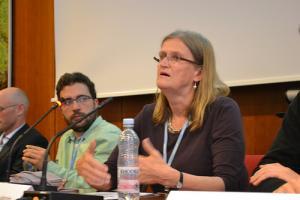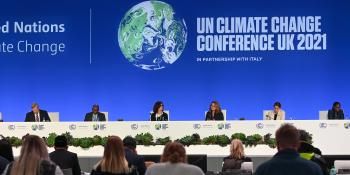New tools mean low emissions development in agriculture more plausible than ever

Live blog from ongoing UNFCCC climate negotiations in Germany
How can you contribute to climate change mitigation? This is a strange question, especially if you were to ask a smallholder farmer in Africa.
But if farmers could benefit from carbon market funds through mitigation activities in agriculture, and also make changes that supported livelihoods, increased food production and enhanced climate resilience, then they might want to engage in low emissions development.
So, what is required to ensure that farmers get financial compensation for mitigation-related activities? And, in addition, what is needed to ensure countries can plan and implement low emissions development linked to agriculture?
The answers to these questions were the main discussion topics at our recent side event “Mitigation and Agriculture: Towards Low Emissions Development”, attracting non-governmental organizations, policy makers and researchers, pulling them away momentarily from the ongoing climate negotiations here in Bonn, Germany.

We lack the emissions data needed!
Several audience members pointed out that there is an inherent issue with current greenhouse gas (GHG) emissions data, which is necessary for when implementing and scaling-up carbon finance projects for instance.
Marja-Liisa Tapio Biström, from the Food and Agriculture Organization (FAO) of the United Nations, described the challenge: The data we have right now on greenhouse gases in relation to agriculture are often lacking in both accuracy and quantity. Problems also arise because organizations depend on data that countries submit themselves, and some countries lack the basic capacity to monitor large areas, nor do they have access to the methods for identifying low emissions development!
"An additional problem is the lack of emissions data from tropical and subtropical areas," Marja-Liisa continued, while urging research organizations like the CGIAR Research Program on Climate Change, Agriculture and Food Security (CCAFS) to take up the challenge to get this data on the table.
But some data do exist, and it is already being used to help decision makers. Marja-Liisa pointed out, “we need to reflect on how accurate we want the data to be. Because the more accurate – the more costly this process will be.” And in the end, what we want is cost-efficient, user-friendly tools that farmers, development practitioners and countries can use to implement and monitor low emissions activities so that they can start to reap the benefits.
Get on top of the latest on greenhouse gas accounting: Moving mitigation forward: Improving quantification of agricultural greenhouse gases
The needs differ for relevant stakeholders as well. Nicholas Berry from University of Edinburgh pointed out that some stakeholders might need GHG data to work on carbon offsetting or performance based-finance. Other countries need it for planning and evaluation. “We need to think about, what is good enough with the tools that we have and link them to the different needs there might be.”
Get the presentations from the session:
What tools and methods exist to get greenhouse gas data?
Getting more data and information from smallholder farms is complex; the landscape is not only diverse but it is also highly fragmented, with millions of small farms covering most of Africa. How do you work under such conditions to measure greenhouse gas emissions and carbon stocks? Many dimensions of the landscape can in fact be assessed together, as evidenced in the SAMPLES approach, presented by Eugenio Diaz-Pines from Karlsruhe Institute.
Read more about SAMPLES: From field to landscape: Tackling mitigation and livelihoods with help from farmers
Another approach for greenhouse gas accounting in Sub-Saharan Africa is the Small-Holder Agriculture Mitigation Benefit Assessment (SHAMBA), which offers an online, interface application, which allows users to investigate current and future environment conditions and land use interventions. The aim is to support decision makers seeking options and opportunities for climate smart agriculture.
Despite their sophistication, both SHAMBA and SAMPLES are only as good as the data available allows them to be.

These tools bring users one step closer to identifying low emissions opportunities within large landscapes. Moreover, they can be used by non-specialists seeking to make informed decisions. Which in time will mean that farmers can be more in control over the mitigation potential on their own plot of land.
Countries will also be able to use tools like these to get correct data and information about their soil and landscapes. When Timm Tennigkeit was welcomed to the stage by Chair James KInyangi Regional Program Leader for CCAFS East Africa, he set out to talk about the National Mitigation Plans (NAMAs) preparations currently being developed.
CCAFS-FAO joint review on the NAMA process: Countries reach for food security while reducing agriculture's climate costs
Right now, 40 per cent of the Nationally Appropriate Mitigation Actions (NAMAs) submissions include agricultural activities. “Synergies with other development objectives have been considered in all agricultural mitigation plans,” he explained to the audience members “which includes increased food security, reduced deforestation, reduced water pollution and heightened adaptation to climate change and more.”
This shows that many developing countries are recognizing low emissions development strategies as a promising pathway to sustainable growth, while protecting their natural capital, but still they need more data and knowledge.
To further improve the tool and data availability, the panel pointed out, we need financial support, investment in making tools available and user-friendly and improve the data quality.
Carbon projects for smallholder farmers: Carbon projects can bear fruit on small farms
More information related to our side event:
Our side event got featured on the IISD
More photos from the event on our Flickr.
Guest article by Theme Leader Lini Wollenberg: Countries Forge Ahead on Mitigation in Agriculture Despite UNFCCC Delays
Cecilia Schubert is a Communications Assistant at CCAFS Coordinating Unit. Follow CCAFS on Twitter for live updates from the Bonn Climate Talks using #SBSTA. More stories from climate conference sessions will be up soon on the blog. Learn more about Pro-poor mitigation. Read additional UNFCCC climate conference blogs from Bonn, Germany.



